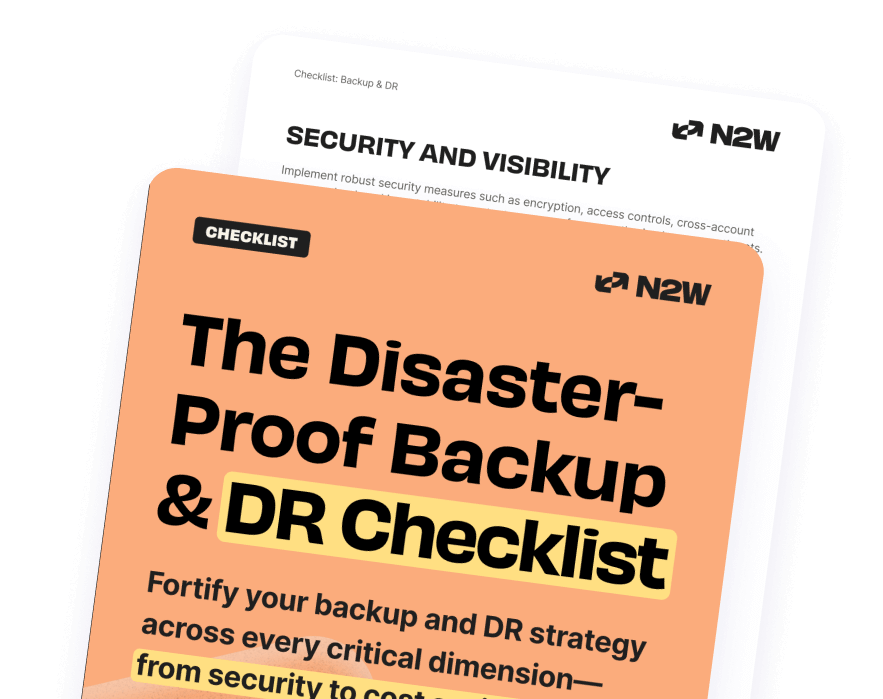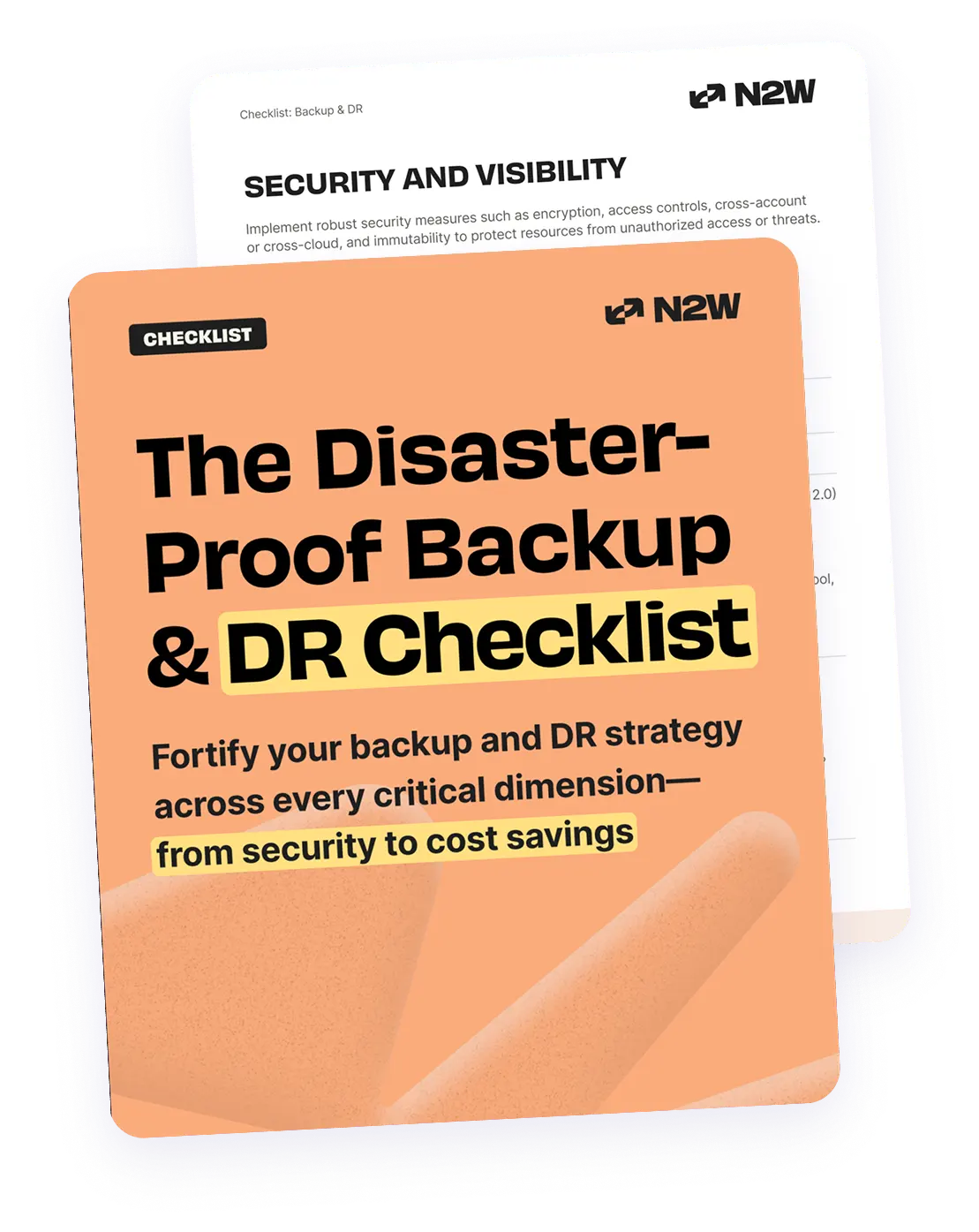What Is a Disaster Recovery Checklist?
A disaster recovery checklist is a structured document that outlines the steps for an organization to recover from unplanned disruptions. This ensures critical business functions remain operational during unexpected events like natural disasters, cyber-attacks, or technical failures. The checklist serves as both a guide and a reference during crises, helping organizations minimize downtime and mitigate risks.
By defining clear procedures and assigning responsibilities, a disaster recovery checklist supports the alignment of resources and efforts during recovery. It includes vital information such as contact lists, system inventories, and backup schedules.
This is part of a series of articles about disaster recovery in cloud
Below you’ll find a disaster recovery checklist with the following sections:
- Perform a Business Impact Analysis (BIA)
- Identify Recovery Objectives
- Assemble a Disaster Recovery Team
- Develop an Incident Response Plan
- Establish Communication Protocols
- Implement Data Backup and Recovery Strategies
- Document Critical Systems and Processes
- Identify Alternative Facilities and Resources
- Conduct Regular Testing and Training
- Review and Update the Plan
1. Perform a Business Impact Analysis
A business impact analysis (BIA) helps organizations identify critical business functions and assess the potential impact of disruptions. It serves as the foundation for disaster recovery planning by prioritizing recovery efforts based on financial loss, operational downtime, legal implications, and reputational damage.
Key steps in conducting a BIA:
- Identify critical processes: Determine which business functions are essential for operations. Examples include financial transactions, customer support, and IT infrastructure.
- Assess dependencies: Identify interdependencies between systems, applications, and third-party services to understand their role in business continuity.
- Estimate downtime impact: Evaluate how long each process can be offline before causing significant disruptions. This includes financial losses, regulatory penalties, and customer dissatisfaction.
- Determine resource needs: List the infrastructure, personnel, and tools required to restore each function efficiently.
- Document findings: Compile a report detailing potential risks, acceptable downtime, and recommended recovery actions.
Learn more in our detailed guide to business continuity vs disaster recovery
Fortify your cloud across every critical dimension.
- Efficiency + Optimization
- Security + Control
- Orchestration + Visibility

2. Identify Recovery Objectives
Recovery objectives define the acceptable limits of downtime and data loss for critical business operations. These objectives guide the selection of disaster recovery strategies and technologies.
Key recovery metrics:
- Recovery time objective (RTO): The maximum allowable downtime before a system or process must be restored. Example: A banking system might have an RTO of 1 hour.
- Recovery point objective (RPO): The maximum allowable data loss measured in time. Example: A company with an RPO of 15 minutes should have backups created every 15 minutes.
Steps to define recovery objectives:
- Analyze business requirements to determine acceptable downtime and data loss.
- Prioritize systems and applications based on their impact on operations.
- Align objectives with BIA findings to ensure realistic recovery expectations.
- Test and refine RTO and RPO values to ensure feasibility with available resources.
3. Assemble a Disaster Recovery Team
The disaster recovery team is responsible for executing recovery procedures during a crisis. Each team member must have a clearly defined role to ensure a coordinated response.
Key roles and responsibilities:
- Disaster recovery manager: Oversees the entire recovery process, coordinates teams, and ensures adherence to protocols.
- IT recovery team: Focuses on restoring hardware, software, and network infrastructure.
- Data management team: Handles data backup, recovery, and verification processes.
- Communications team: Manages internal and external communication, keeping stakeholders informed.
- Compliance & security team: Ensures legal and regulatory requirements are met during recovery.
Steps to assemble the team:
- Identify key personnel from IT, operations, and security teams.
- Define roles and responsibilities for each team member.
- Create an emergency contact list with primary and backup contacts.
- Conduct regular training and simulations to improve readiness.
4. Develop an Incident Response Plan
An incident response plan (IRP) outlines the immediate steps to take when a disaster occurs. It focuses on containment, mitigation, and initial recovery actions.
Key components of an IRP:
- Incident classification: Define categories based on severity (e.g., minor outage vs. full system failure).
- Initial response actions: Detail the steps to assess the impact and initiate recovery.
- Escalation procedures: Outline when to escalate an incident to higher management or external agencies.
- Mitigation strategies: List immediate actions to contain damage, such as isolating affected systems.
- Communication protocols: Define how and when to notify stakeholders about the incident.
Steps to Develop an IRP:
- Conduct risk assessments to identify potential threats.
- Define response procedures for different disaster scenarios.
- Ensure alignment with compliance requirements (e.g., GDPR, HIPAA).
- Regularly test and update the IRP to adapt to new threats.
5. Establish Communication Protocols
Clear communication is crucial during disaster recovery to keep employees, customers, and stakeholders informed.
Key elements of communication protocols:
- Predefined messaging: Draft templates for different scenarios (e.g., cyberattack, system outage).
- Communication channels: Use multiple channels like emails, SMS alerts, and collaboration tools (e.g., Slack, Microsoft Teams).
- Stakeholder notification plan: Identify who needs to be informed (employees, customers, vendors, regulators).
- Crisis communication team: Assign personnel to handle media inquiries and customer support.
- Regular updates: Provide real-time status updates on recovery progress.
Steps to establish communication protocols:
- Identify primary and backup communication channels
- Ensure contact lists are up to date and accessible
- Define roles for internal and external communication teams
- Test communication systems regularly to ensure reliability
- Incorporate AI-driven anomaly detection: These tools can monitor system performance and detect early warning signs of potential failures or cyberattacks before they escalate into disasters.
- Leverage immutable backups: These cannot be altered or deleted, even by administrators. This protects against ransomware attacks that attempt to encrypt or destroy backup data.
- Establish a tiered application recovery strategy: Prioritize recovery efforts based on business impact. Critical applications (e.g., financial transactions, customer databases) should have near-instant recovery, while less essential systems can have longer timelines.
- Implement Just-In-Time (JIT) access controls: Restrict access to disaster recovery tools and credentials using JIT, which grants permissions only when needed and automatically revokes them after use. This minimizes insider threats.
- Avoid scripting failover procedures: Automate failover processes using tools like N2W to reduce human error and accelerate recovery times. DR drills can be automatically run to ensure reliability.
6. Implement Data Backup and Recovery Strategies
Data backups are critical for disaster recovery, ensuring that business operations can resume with minimal data loss. Organizations should use a multi-layered backup strategy to protect against different types of failures.
Key backup strategies:
- Full backups: A complete copy of all data, performed periodically.
- Incremental backups: Backs up only data changed since the last backup, saving storage space.
- Differential backups: Backs up all changes since the last full backup.
- Cloud-based backups: Provides off-site storage for data redundancy.
Related content: read our guide to AWS disaster recovery
Strategic, resiliency and cost considerations:
It’s important to include additional layers that protect against account-level security breaches, geographic downtime, employee errors, and cloud provider outages. It’s also recommended to store your backups efficiently for optimal cost efficiency. (TIP: read our guide to optimizing disaster recovery cost)
A comprehensive backup strategy may include:
- Cross-region backups which protects against regional outages or disasters
- Cross-account or Cross-subscription backups which isolates your backups and protects them from any corruption, whether intentional or accidental
- Cross-cloud backups which protects against a single cloud provider failure or outage. This strategy is becoming extremely important as enterprises choose to diversify their backups and not depend on one vendor.
- Immutability which provides tamper-proof protection for your backups –preventing anyone (even the root user) from deleting or modifying your backups
- Implementation of Data Lifecycle Management which automatically transitions backups to cold, tiered storage, minimizing long-term storage expenses.
Steps to implement backup strategies:
- Determine backup frequency based on RPO requirements.
- Use automated backup tools to reduce human error and to streamline additional layers of your strategy
- Encrypt sensitive backup data for security.
- Regularly test backups to ensure they can be restored.
7. Document Critical Systems and Processes
Comprehensive documentation ensures a structured recovery process. This includes system configurations, application dependencies, and restoration procedures.
Key elements to document:
- System inventory: List all hardware, software, and cloud services.
- Configuration details: Document settings for databases, networks, and applications.
- Access credentials: Securely store login details for critical systems.
- Step-by-step recovery procedures: Provide clear instructions for restoring each system.
Steps to maintain documentation for disaster recovery:
- Update documentation regularly to reflect system changes.
- Store copies in secure, easily accessible locations.
- Provide role-based access to sensitive documents.
8. Identify Alternative Facilities and Resources
Organizations should have alternative workspaces and backup infrastructure ready in case of physical disasters.
Key alternative resource strategies:
- Secondary data centers: Maintain an off-site or cloud-based environment for failover.
- Remote work capabilities: Ensure employees can work remotely during disruptions.
- Third-party vendors: Partner with external providers for emergency resources.
Steps to identify alternative resources:
- Assess infrastructure requirements for backup sites.
- Test remote work capabilities to ensure business continuity.
- Negotiate contracts with third-party providers for emergency support.
9. Conduct Regular Testing and Training
Regular testing and training ensure that disaster recovery plans remain effective and that personnel are prepared to respond efficiently during a crisis.
Types of testing:
- Tabletop exercises: Teams review hypothetical disaster scenarios and discuss response actions. This helps identify gaps in planning without disrupting operations.
- Functional testing: Select systems or processes are tested for recovery, such as restoring a database or switching to a backup network.
- Full-scale drills: A complete simulation of disaster recovery procedures, involving all relevant teams and systems to validate recovery time objectives (RTOs) and recovery point objectives (RPOs).
- Failover testing: IT systems are intentionally switched to backup environments (e.g., cloud or secondary data centers) to assess their resilience.
Training strategies:
- Role-specific training: Ensure employees understand their specific responsibilities in the recovery process.
- Cross-department collaboration: Conduct joint training exercises to improve coordination between IT, operations, and leadership teams.
- Crisis response workshops: Provide hands-on practice in incident response, data recovery, and communication protocols.
- Produce comprehensive disaster recovery test success reports: Ensures that all stakeholders, auditors and compliance teams have evidence that your organization has business continuity procedures in place
Review and Update the Plan
A disaster recovery plan is not a static document; it must be reviewed and updated regularly to reflect changes in technology, business processes, and emerging threats.
When to review the plan:
- Quarterly review: Conduct a formal assessment at least once a year to update policies, contact lists, and recovery strategies.
- After system changes: Any significant updates to IT infrastructure, applications, or service providers require adjustments to the plan.
- Post-incident analysis: If a disaster or outage occurs, conduct a thorough review to identify what worked well and what needs improvement.
- Regulatory changes: Ensure the plan aligns with evolving compliance requirements and industry best practices.
Steps for updating the plan:
- Revise roles and responsibilities if personnel changes occur.
- Update vendor contracts to confirm continued support in emergencies.
- Ensure backups and failover systems remain aligned with current data and workloads.
Communicate changes to all stakeholders and ensure they have access to the latest version.
